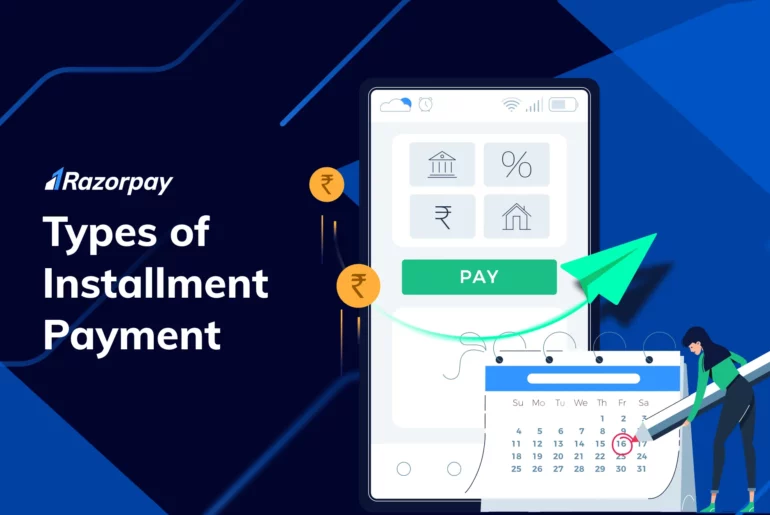Installment payment is a financial arrangement where a large sum of money is divided into smaller, manageable payments over a specified period. This concept is commonly used for various financial transactions, such as loans, credit card balances, and purchasing retail goods.
In this article, we will delve into installment payment meaning, types of installment payments and examples to illustrate how they work.
Table of Contents
What is Installment Payment?
Installment payment is a method where you can pay off your invoices in smaller, manageable chunks over a specified period. It allows both individuals and businesses to make larger expenses more accessible by dividing them into smaller payments. This flexible payment option provides convenience and financial flexibility to both buyers and sellers.
From a business perspective, offering installment payments can attract more customers and increase sales. Customers are more likely to make a purchase when they have the option to pay in installments.
For general consumers or e-commerce shoppers, installment payments offer the opportunity to make big-ticket purchases without straining their budgets. Instead of paying the entire amount upfront, they have the convenience of spreading the cost over time.
To accept installment payments, businesses must integrate suitable payment methods into their platforms. They can partner with payment gateways or use invoicing software for installment options.
The payment process is generally straightforward for customers; you need to select the installment plan during checkout and provide your payment information. Payments are then automatically deducted regularly until the invoice is fully paid.
Related Read: How to Create a Payment Schedule Format That Works
What are the Different Types of Installments?
Installment payments are a prevalent method for dividing significant expenses into small and periodic payments, thus making them more manageable.
Businesses offer various types of installment payments to attract and accommodate customers –
- Equal installments: You pay the same amount regularly until the full payment is made.
- Unequal installments: You pay varying amounts regularly, often based on a predetermined schedule.
- Down payment installments: You make an initial down payment, followed by regular installments.
- Balloon payments: You make smaller payments throughout the installment period, ending with a larger final payment.
Installment Payment Example
To understand installment payments better, let’s look at a practical example. Suppose you want to purchase a new smartphone worth ₹30,000. Instead of paying the entire amount upfront, you can opt for an installment plan the seller provides. In this scenario, the seller may offer you the option to pay in 12 equal installments of ₹2,500 each over a year (This can also include interest rate, if applicable, and any associated bank charges). This way, you can manage your expenses more effectively while enjoying your new phone.
Another real-life instance of installment payment is when individuals enrol in educational courses. Many institutes offer flexible payment plans where students can pay for their courses in installments rather than paying the full fee upfront. This allows students to pursue their education without facing financial burdens.
Similarly, furniture stores often offer installment options. This enables you to furnish your home without straining budgets.
e-Commerce Installment Payment Options
- Interest-free installments: You can divide your payments into several equal installments over a specific period without incurring additional interest charges.
- Deferred Payment or Buy Now, Pay Later (BNPL) schemes:
Buy Now, Pay Later allows you to make purchases and delay payment until a later date or spread it out across multiple installments. BNPL is a new type of deferred payment service or payment method that has emerged with the expansion of digitization and e-commerce buying.
Both Deferred payments and BNPL provide users with the convenience and ease of use, option to pay through multiple payment methods, and are free of charge when payments are made on time.
Related Read: What is ECOM Transaction?- How it works & Benefits
Managing Installment Payments with Invoicing Software
Invoicing software is an essential tool for effectively managing installment payments. By automating and simplifying the process, businesses can track and receive payments from customers seamlessly.
With invoicing software, businesses can set up recurring invoices for installment payments, ensuring timely reminders are sent to customers. It also provides options to customise invoice templates, making it easier to include payment terms and details for each installment. This streamlines the payment collection process and improves cash flow management.
Let’s understand some features of invoicing software that can help a business.
Partial payments
Partial payments occur when a customer pays only a portion of the total amount owed instead of the full amount. With invoicing software, businesses can easily track and manage these partial payments. The software will keep a record of how much has been paid and how much is still outstanding, ensuring that the business has accurate and up-to-date information on each customer’s payment status.
Recurring invoices
Recurring invoices involve the automated generation and sending of invoices regularly. This feature of invoicing software is handy when dealing with installment payments over an extended period. With recurring invoices, businesses can set up automatic reminders for customers to make monthly installments. This helps ensure that customers stay on track with their payment schedule and reduces the risk of missed or delayed payments.
Frequently Asked Questions
1. What is the difference between installment and payment?
The difference between installment and payment lies in their nature. “Installment” refers to dividing a large sum into smaller, scheduled payments. In contrast, “payment” is settling a debt or making a financial transaction.
2. Is EMI an installment?
Yes, EMI (Equated Monthly Installment) is a type of installment specifically used for repaying loans or making purchases in periodic payments of equal amounts.
3. Is installment a credit or debit?
Installment is neither a credit nor a debit; it is a method of payment arrangement. Whether it results in a credit or debit depends on the context, such as whether it’s used to pay off a debt (credit) or to receive a payment (debit).
4. What is installment transaction?
An installment transaction is a financial arrangement where a purchase or loan amount is divided into multiple smaller payments over a set period, making it more manageable.





